In this article, I compare Factors.ai vs. Common Room across features, pricing, and practical fit so marketing and sales teams can choose the platform that best supports their account-based marketing program.
I also explain where ZenABM fits in as a lightweight, budget-friendly alternative or a complementary layer to these enterprise ABM suites because its approach is different.
Read on…

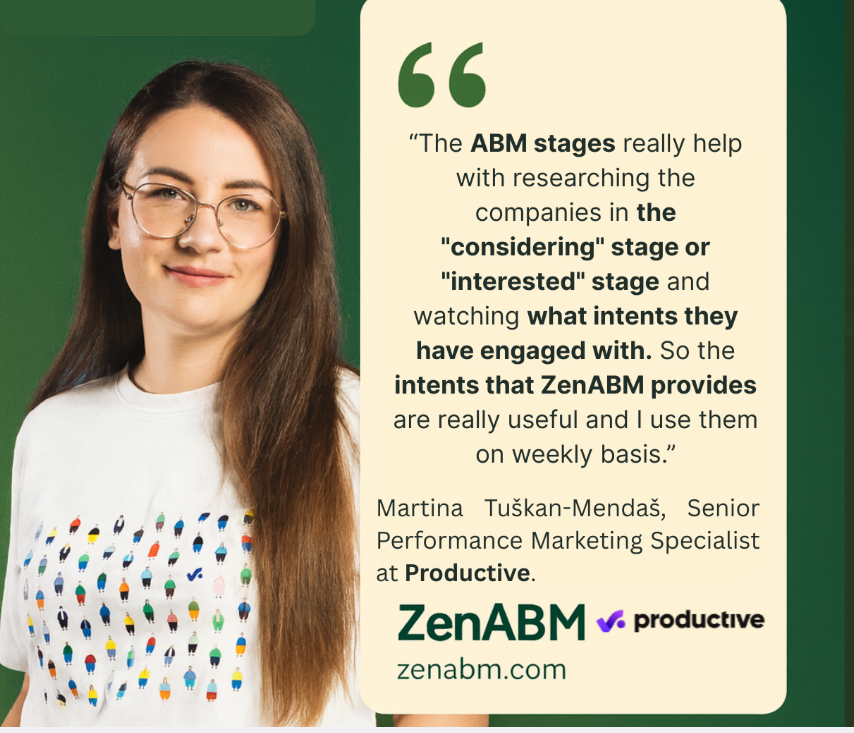
Factors.ai vs. Common Room: Quick Summary
- Factors.ai focuses on ad performance, attribution, deanonymization, and campaign-driven ABM.
- Common Room excels at multi-source signals, community and product insights, and person-level activation for sales.
- Pricing differs: Factors.ai uses gated quotes with a free tier, while Common Room starts around $1k per month.
- Time to value: Factors.ai lands fast for marketing teams running paid campaigns, Common Room ramps quickly for sales-ready signal use.
- ZenABM is presented as a lean, LinkedIn-first alternative that provides accurate first-party account engagement, CRM sync, scoring, and ABM workflows at a much lower cost.
Factors.ai Overview: Key Features, Pricing, and More
Factors.ai presents itself as an “all-in-one” ABM intelligence and analytics platform for B2B marketers.
Its core proposition is to bring web, advertising, and CRM data together so you can view the full account journey end to end and turn those insights into action.
Below are the standout capabilities, pricing posture, and typical use cases.
Multi-Touch Attribution & Journey Analytics
Factors.ai can capture and attribute touchpoints across channels such as site, ads, email, and CRM activities, then apply multiple attribution models.
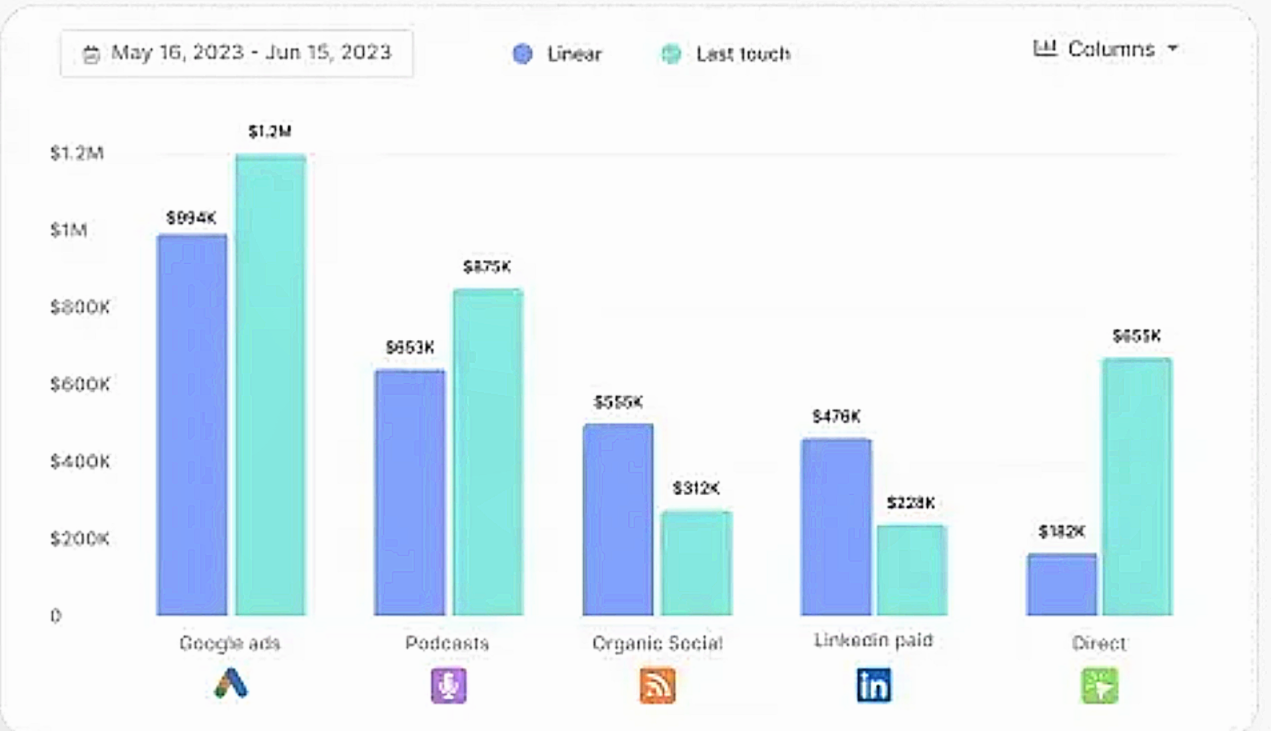
It supports roughly nine models, including first-touch, last-touch, linear, time-decay, U-shaped, and W-shaped, and lets you compare two models side by side.
This gives marketers a defensible read on which campaigns and assets influenced pipeline and revenue instead of relying on single-touch views.
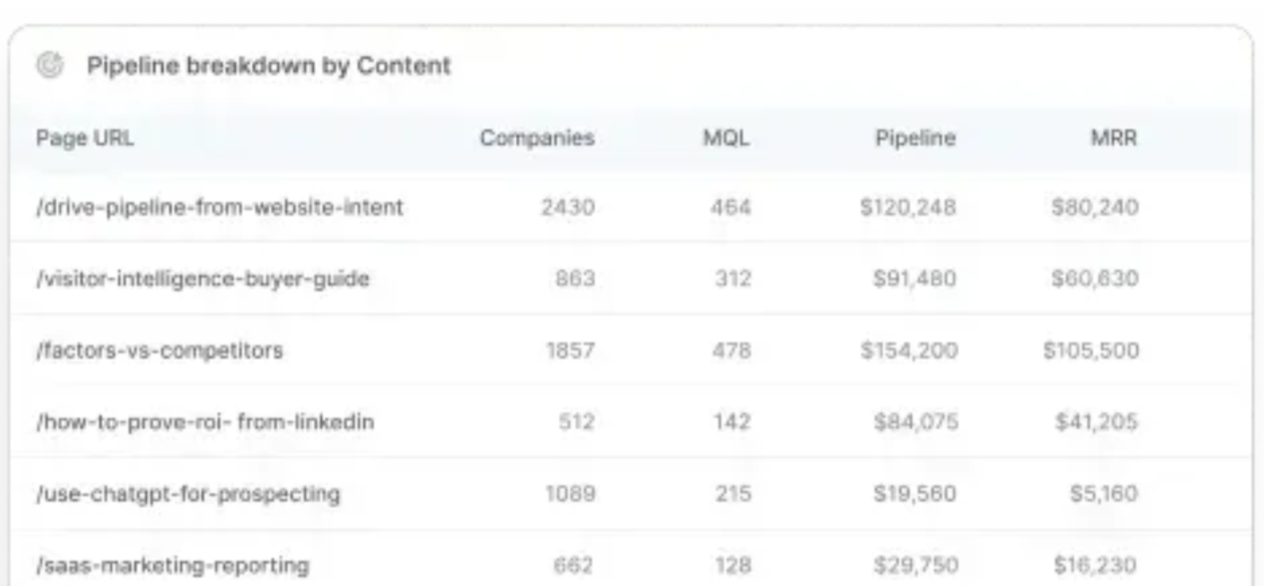
All activity flows into an Account Timeline that maps each company’s chronological path across anonymous sessions, ad interactions, and sales engagement.


Website Visitor Identification (Site-to-Account Matching)
A key capability in Factors.ai is linking anonymous visitors to the companies browsing your site.
By using IP data and partners like Clearbit Reveal and 6sense, Factors.ai notes it can deanonymize up to roughly 64 percent of traffic by matching IPs to corporate domains.
In practice, if a visitor from Acme Corp lands on your site, Factors.ai may identify the company and display “Acme Corp” in your dashboard with firmographics such as industry and company size.
This site-to-account resolution fuels an “Account Intelligence” area so you can see which target accounts are active across your properties.
Account Intelligence & Scoring
Factors.ai augments accounts with firmographics and intent data.
Using Clearbit, it can enrich industry, headcount, revenue band, location, and similar attributes.
Through 6sense or other providers, it can reflect buying stages or topic-level intent.
All account engagement, including pageviews, ad impressions or clicks, and form fills rolls into an engagement score.
Scoring is configurable, blending fit with observed engagement to surface warm accounts. Engagement metrics are analyzed to identify high-quality leads, helping sales teams prioritize accounts most likely to convert.

Advertising Analytics and AdPilot
Factors.ai connects with major ad platforms like LinkedIn, Google Ads, Meta, and Microsoft Ads to ingest performance and sync audiences.
It also provides an AI-assisted LinkedIn AdPilot that helps streamline LinkedIn ABM operations.
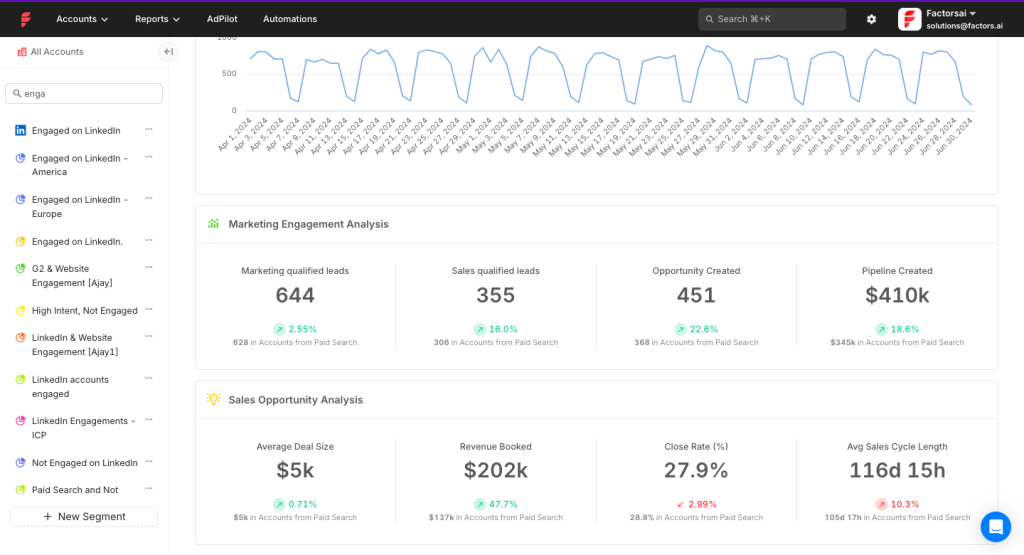
AdPilot can auto-build audiences from Factors segments and set impression limits per account, so you avoid over-serving the same companies.

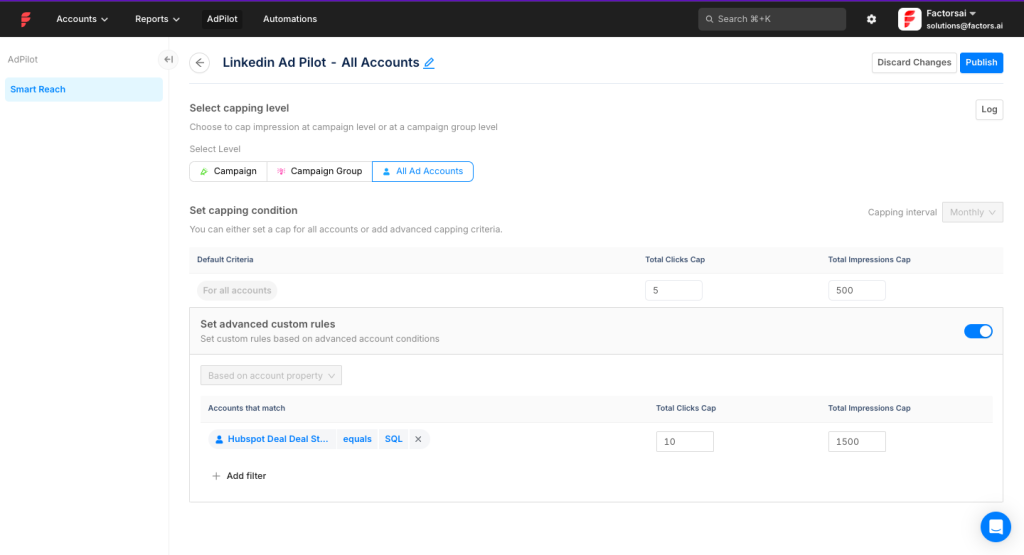
Factors.ai also captures impression-level LinkedIn data, not just clicks, enabling view-through attribution so you can credit influence without a click.
Pro Tip: Like Factors.ai, ZenABM records company-level LinkedIn engagement down to impressions, and goes further by showing which ads a given account interacted with, so you get real interests, not just raw activity.
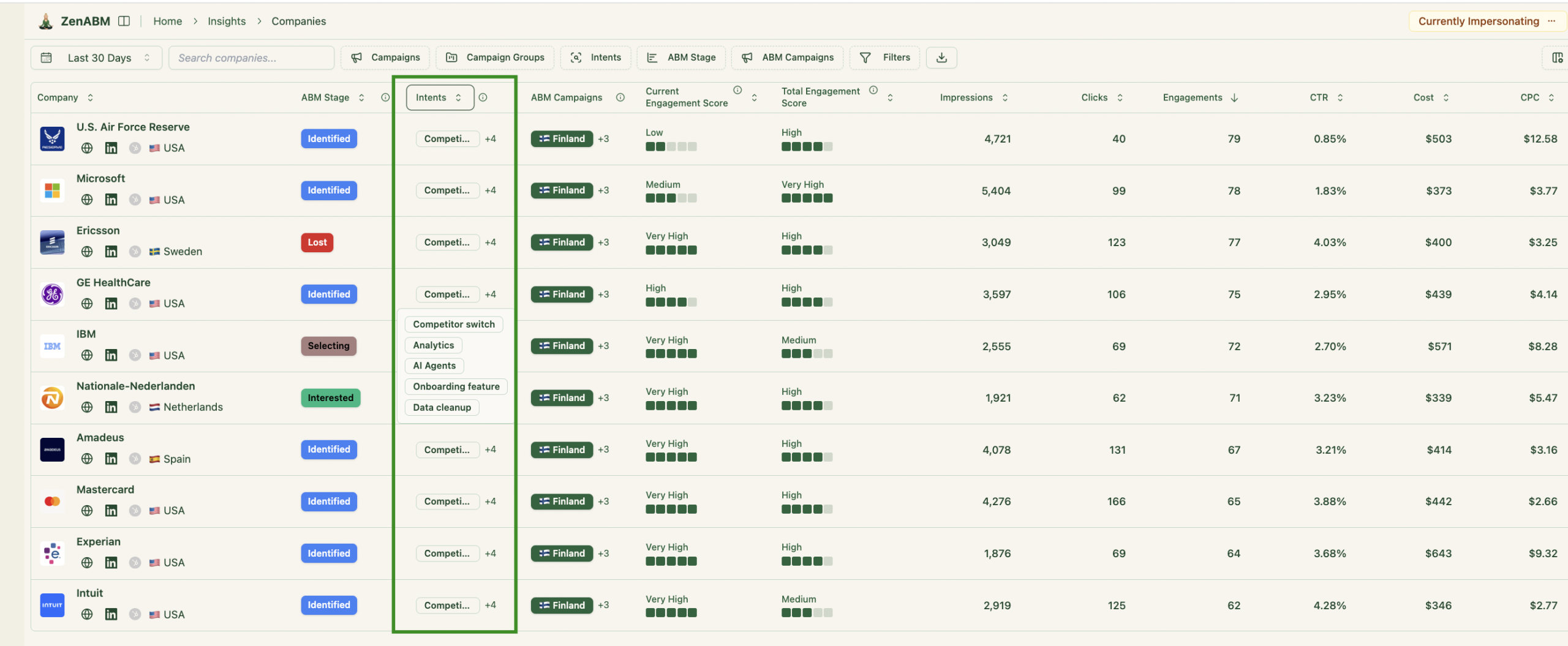
Tag campaigns by theme or feature, and ZenABM will surface each account’s intent and sync both qualitative and quantitative insights to your CRM.
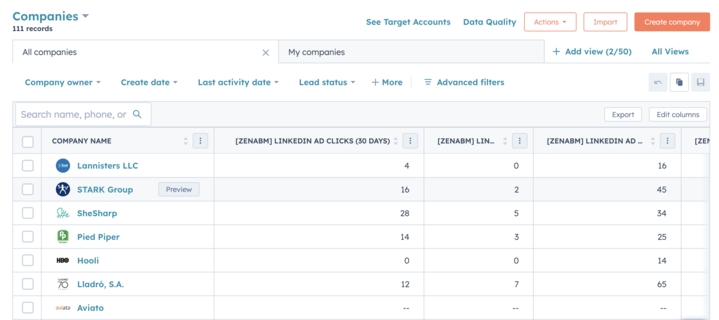
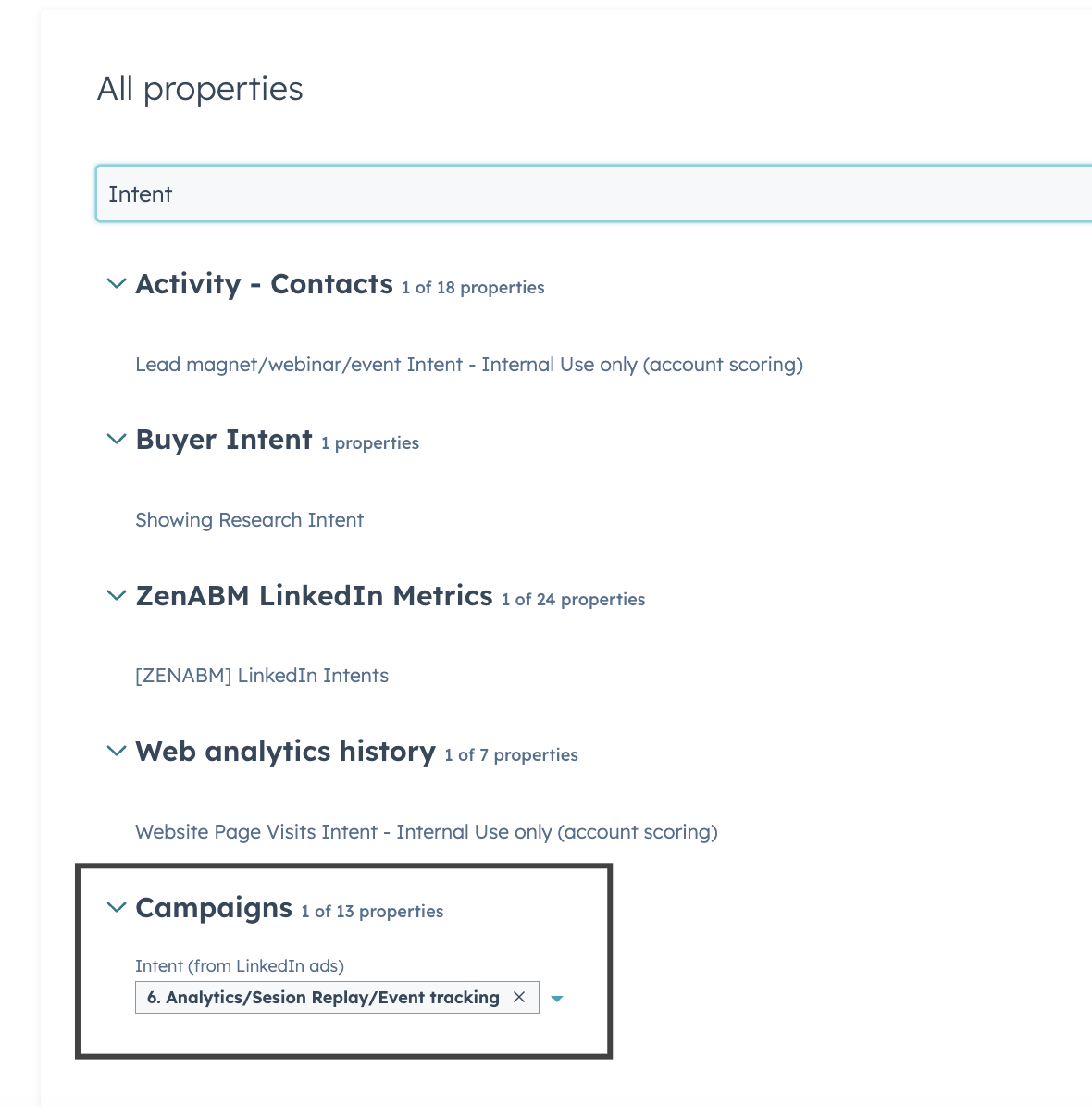
This gives BDRs immediate context on who is heating up and which topics to lead with during outreach.
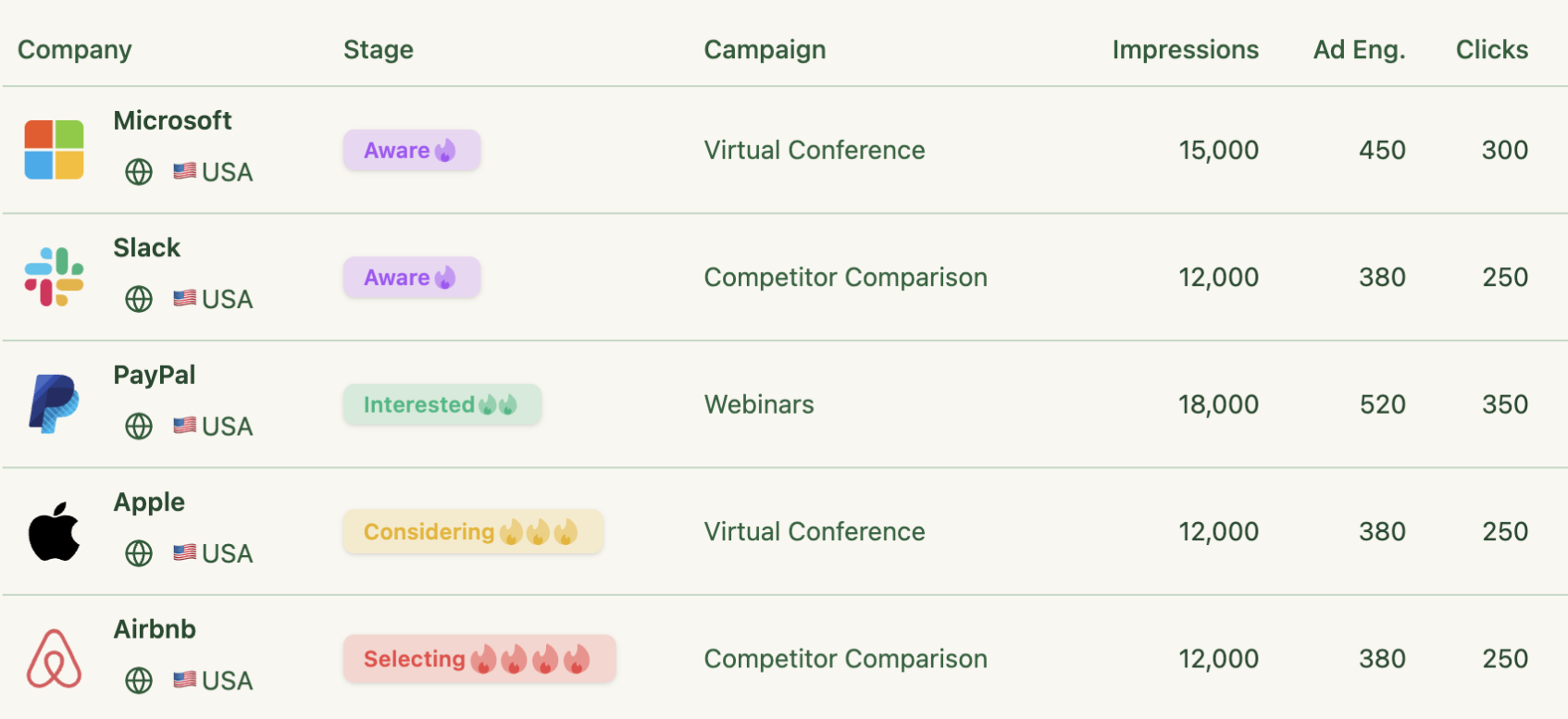
Reporting & Analytics
Beyond attribution, Factors.ai offers ABM analytics dashboards.
You can monitor metrics like Visits by target account, Pages per account, and Ad impressions per account to gauge engagement across the site and ads.
Higher tiers unlock prebuilt ABM dashboards showing which campaigns lift account engagement, how targets distribute by funnel stage, and which opportunities marketing influenced.
You can also build custom reports, with limits that increase by plan, for example, Basic includes roughly ten custom reports.
Some G2 reviewers note that custom reporting can feel constrained.
Other commonly mentioned friction points include:
- A steep learning curve, especially for non-technical users, which can impact adoption and highlights the need for stronger onboarding.
- Occasional gaps in visitor identification or attribution.
- UI sluggishness when building segments.
- Some Salesforce sync steps still need manual handling.
Factors.ai Pricing
Factors.ai follows a multi-tier approach with a free plan plus paid packages.
The platform offers several paid plans, each with different features and usage limits, allowing teams to choose the best fit for their needs.
Exact pricing is not public. The site stresses “custom pricing built for your needs” and directs teams to book a demo for quotes.
Officially, the four tiers are:
- Free: Test core capabilities like identifying which companies visit your site, with no commitment.
- Basic: An entry tier focused on turning anonymous traffic into qualified leads for sales.
- Growth: For teams seeking richer account insights, stronger targeting, and deeper analytics.
- Enterprise: For large ABM programs requiring advanced targeting and analytics.
All plans include the foundational account identification and analytics layer.
A free trial is available so you can validate outcomes before purchasing.
As a directional benchmark, Factors.ai often falls in the $10k to $25k annual band.
Common Room Overview: Key Features, Pricing, and More
Common Room is a comprehensive customer intelligence and ABM platform that unifies signals from dozens of sources to provide a 360° view of prospects.
This enables comprehensive tracking of customer interactions and supports customer success efforts by integrating signals across channels, helping teams better understand and engage with their audience.
So, the name is well chosen.
It’s a “common room” where web, product, community, and more converge into a single workspace.
Unlike many ABM tools, Common Room takes a deeply person-centric approach.
Here are the core capabilities:
Massive Signal Integration

Common Room ingests buying signals from 50+ native integrations across social, community, CRM, product analytics, and more.
These include Slack, Discord, GitHub, LinkedIn, Twitter, Salesforce, HubSpot, Marketo, plus sites like G2 and Stack Overflow. Common Room captures buyer intent signals from social media platforms and integrates seamlessly with CRM tools, making it especially valuable for CRM users who need unified data across sales and marketing workflows.
All integrations are code-free, so connecting sources is straightforward.
AI-Powered Identity Resolution (Person360™)
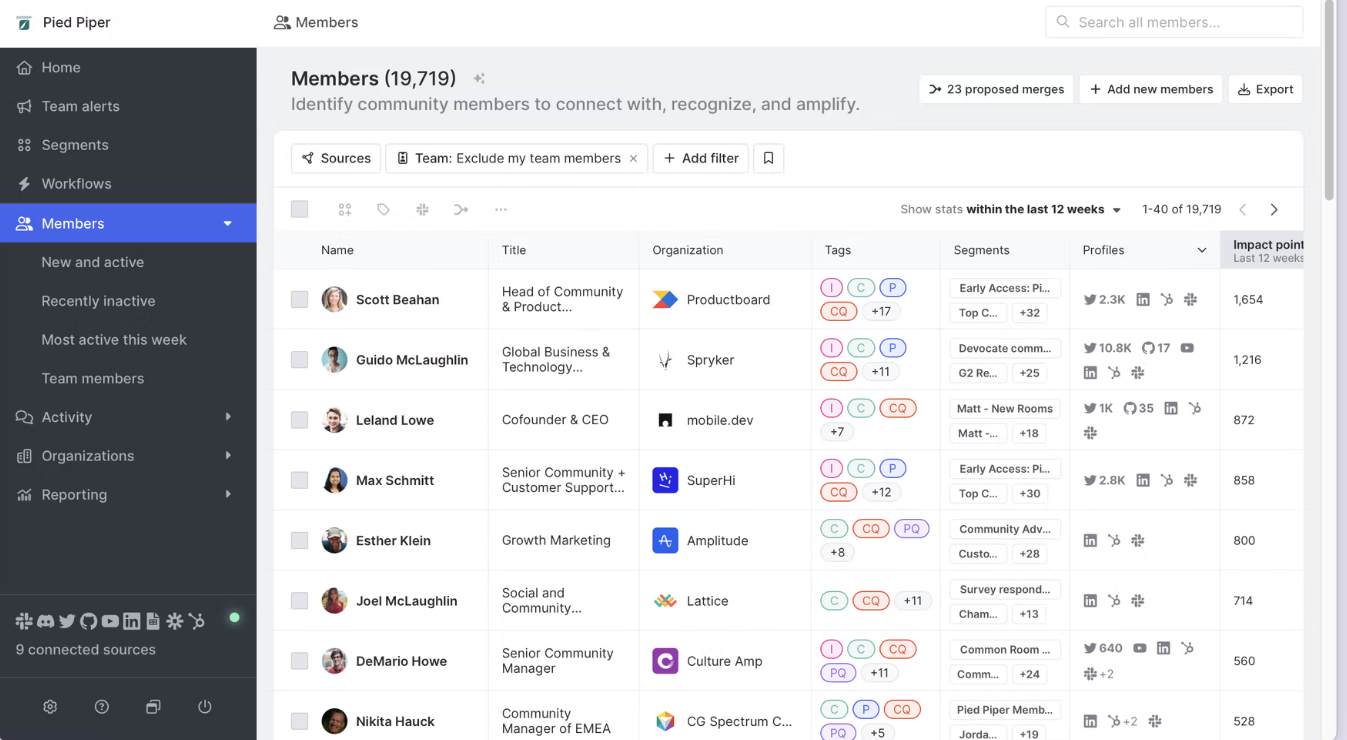
Once connected, Common Room’s Person360™ AI combines activities into unified contact and account profiles.
It uses advanced matching beyond simple email to merge identities across channels, flagging questionable matches for human review.
The result is a single, reliable profile for each lead.
For example, once identified, an anonymous web visitor can be tied to the same person’s Slack or GitHub presence.
After resolution, a waterfall enrichment step appends firmographic and technographic attributes (company size, industry, tech stack, etc.) from extensive data partners, refreshing daily. The platform also appends contact details such as email addresses and phone numbers to each profile, making it easier to connect with leads.
Lead & Account Scoring
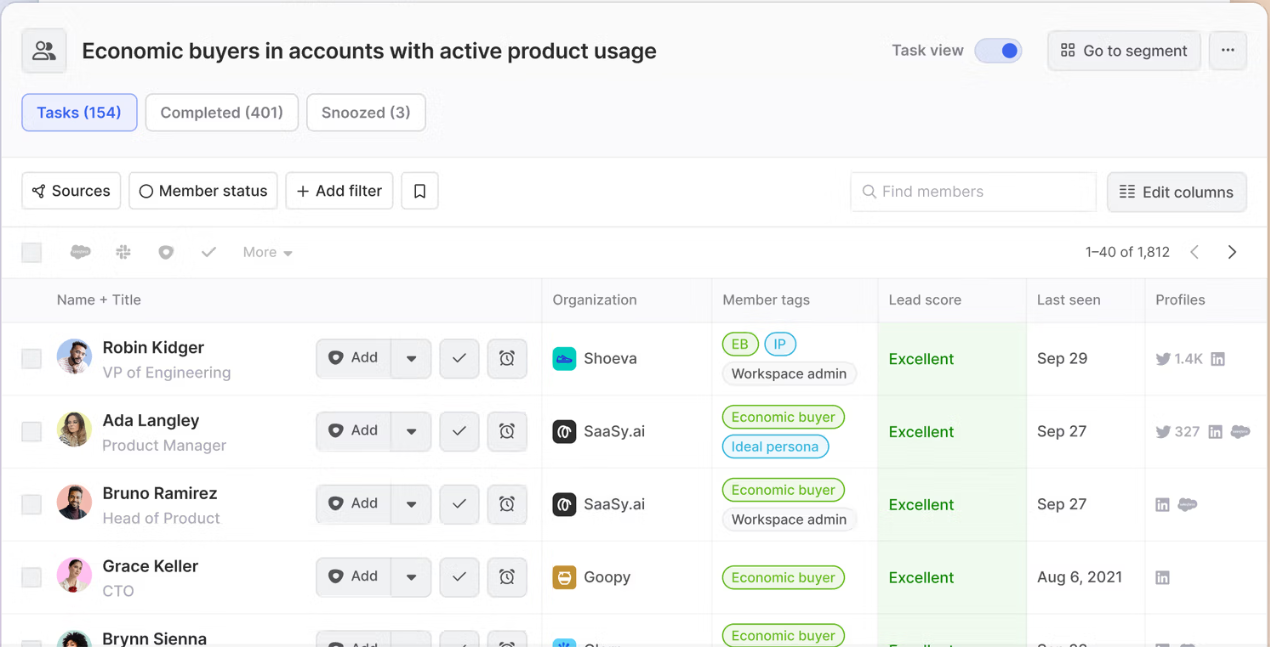
Common Room’s AI (RoomieAI™) scores and filters leads by fit and intent, making it easier for teams to identify and prioritize high-intent leads for sales prospecting.
Teams can create custom scoring models mixing signals like job seniority, product usage, and community actions with firmographic criteria.

The platform accepts hundreds of buying signals as inputs, from email opens and form fills to GitHub stars and G2 visits.
Scores aggregate at both the contact and account levels, so sellers get prioritized lists of high-fit, high-intent prospects.
For example, Notion’s sales team tags “high-fit” accounts and triggers Slack alerts when those accounts show purchase-ready behavior.
By the way, ZenABM also supports account scoring based on LinkedIn ad engagement:

So, if your ABM is LinkedIn-centric, consider ZenABM.
Prospector Database

Beyond internal data, Common Room provides a prospecting tool tapping a database of 200M+ contacts.
Enter ICP filters like industry, function, and size, and the system suggests net-new accounts and contacts with scores based on third-party enrichment.
This feature plays a key role in lead generation by identifying and surfacing new potential customers for your outreach.
This expands reach by surfacing lookalike prospects you may have missed.
Website Visitor Tracking
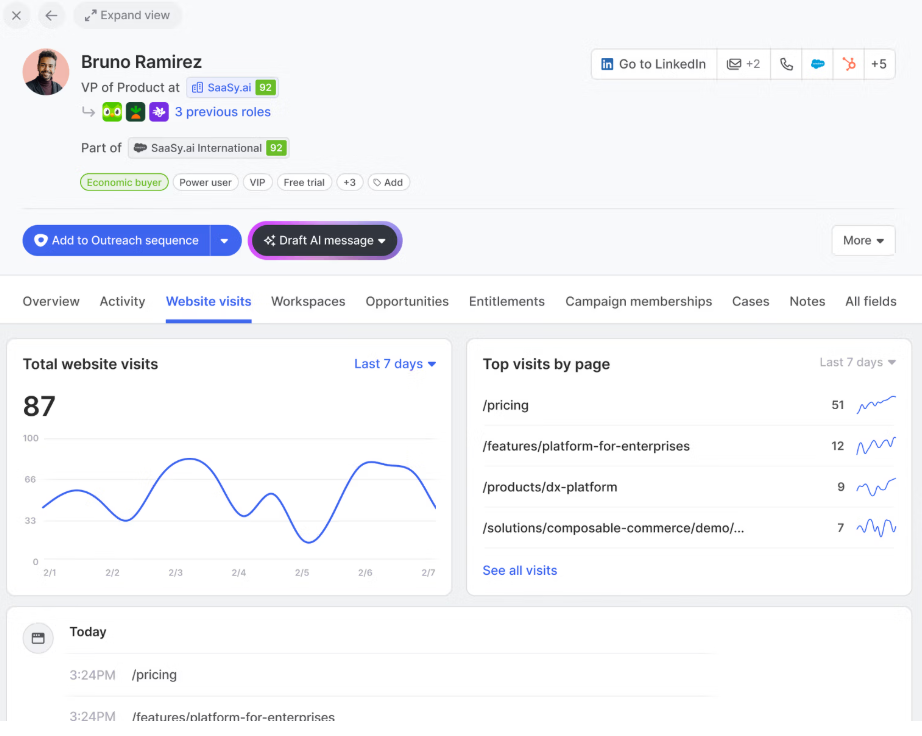
Common Room also identifies account-level site traffic.
Using a first-party cookie and IP lookup, it can attribute a visit to a company even before a user is personally known.
Once that person converts, historical web activity is attached to their profile.
This helps marketing see if a target account has been studying pricing or docs before raising a hand.
Pro Tip: IP-based deanonymization often tops out around 42% accuracy (as one study found).

ZenABM recommends running inexpensive LinkedIn text ads aimed at site visitors to reveal engaged companies.
Text ads on LinkedIn have very low CTRs, so they are cheap to serve, and ZenABM will show which companies saw those impressions frequently, indicating employees likely visited key pages.
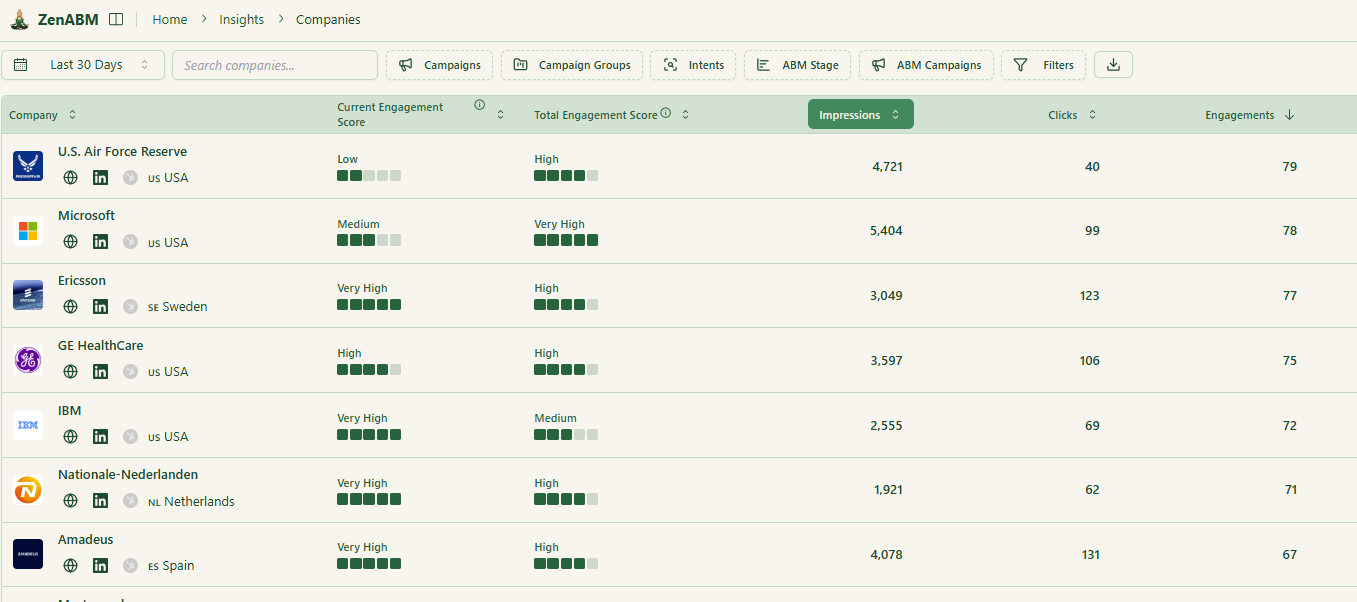
This first-party deanonymization approach can identify engaged accounts more reliably than fuzzy IP matches and at near-zero cost.


Community & “Dark Funnel” Insights
A signature strength of Common Room is its coverage of community and developer channels, the “dark funnel” where interest forms before formal sales engagement.
It links with Slack, Discord, Discourse, GitHub, Reddit, and more to capture meaningful activities.
For instance, if an engineer at a target account asks a question in your Slack or stars your GitHub repo, Common Room attributes that to the person and the account.
Reps can be notified and reach out with context.
For example, “Noticed you explored our GitHub project. Can I help with anything?”
Workflow Automation and Alerts
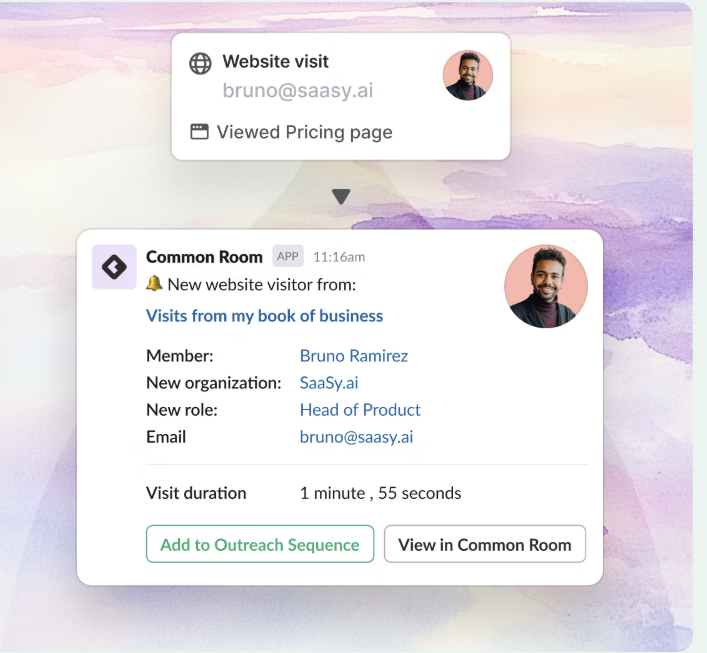
Common Room makes acting on insights easier with built-in automation.
Team Alerts support near real-time triggers. Real-time Slack alerts notify sales teams instantly about buying signals and high-priority leads, ensuring timely follow-up and streamlined engagement.
There’s also a no-code builder to create multi-step workflows.
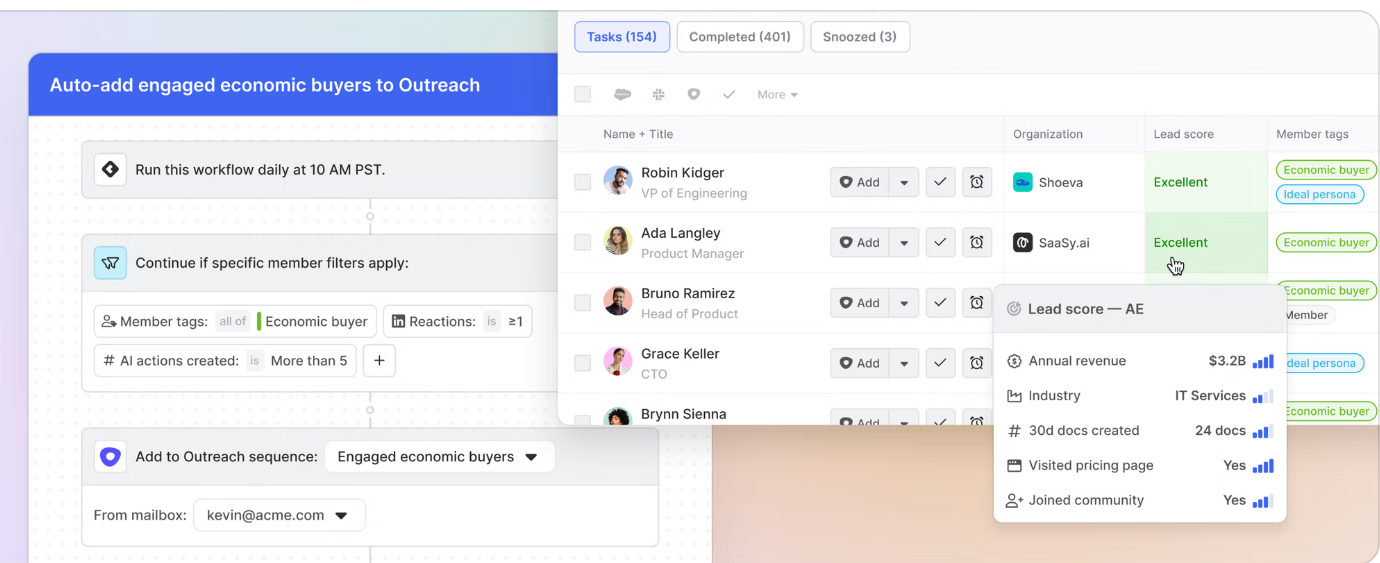
AI Outreach Assistant

To complement its intelligence layer, Common Room includes RoomieAI™ Activate.
It is an AI assistant for drafting sales emails.
It can generate personalized messages using the prospect’s specific signals and context.
Note: G2 feedback on AI-generated copy is mixed, with some users finding it generic without additional tweaking.
Integrations Ecosystem
Common Room natively connects to a wide range of tools so it fits into existing workflows.
Integrations include CRMs (HubSpot, Salesforce), marketing and sales systems (Marketo, Outreach, 6sense, Demandbase, etc.), data warehouses (Snowflake, BigQuery), community platforms (Slack, Discord, InSided), and more.
For details, visit Common Room’s Docs.
Common Room Pricing

Common Room is a premium B2B product, and pricing scales with tracked contacts and seats.
The Starter tier (about $1,000/month billed annually) includes roughly 35,000 contacts and 2 seats with core integrations and unlimited alerts/workflows.
The Team tier (around $2,500/month) lifts limits to roughly 100,000 contacts and 5 seats.
Both tiers include core capabilities like visitor tracking, Person360 enrichment, and workflow automation.
An Enterprise plan (custom) supports ~200K+ contacts, 10+ seats, advanced integrations such as full Salesforce sync with custom objects, and dedicated support.
A free trial is also available on the Team plan without a credit card.
Factors.ai vs. Common Room: Key Differences
Major differences between Factors.ai vs. Common Room that you should review:
| Dimension | Factors.ai | Common Room |
|---|---|---|
| Positioning and scope | Factors.ai presents an AI-powered demand generation and ABM analytics platform. It consolidates ad, web, and CRM signals to identify accounts, run ABM programs, and measure ROI, with AI agents that automate GTM tasks. | Common Room positions a signal and intent layer for GTM that captures multi-source account signals, maps them to real people, and powers SDR and AE outreach. It is less about buying media, more about converting activity into contact-level action. |
| Signals and intent | Factors.ai focuses on first-party and advertising signals, deanonymized account traffic, and journey analytics that connect impressions and clicks to the pipeline. | Common Room emphasizes community, product, social, review and website signals. It resolves those signals to specific contacts, then triggers alerts and workflows. |
| Activation and orchestration | Factors.ai concentrates on practical ABM workflows around paid campaigns and attribution. The pitch centers on knowing what worked by account, then acting on it. | Common Room focuses on operationalizing signals, segments, and automations that deliver person-level context to sellers, rather than managing ads. |
| Analytics and attribution depth | Factors.ai is built to answer what influenced opportunities and revenue across channels like LinkedIn and Google, and to recommend next actions. | Common Room reports across connected sources, then pushes prioritized people and plays into rep workflows. |
| Integrations and sales workflow | Factors.ai integrates with ad platforms, analytics, and CRMs to consolidate signals and surface account insights for marketing and sales, while also supporting sales reps with real-time alerts and activity tracking to help them engage leads more effectively | Common Room highlights SDR and AE usability on top of its signals, with person-level enrichment, fast outreach, and features that provide sales reps with real-time activity notifications and engagement insights. |
| Pricing posture | Factors.ai lists a Free plan and named paid tiers. Dollar amounts are currently gated behind a demo, although their content references tier names and ranges. | Common Room publishes starting points. Starter begins at about 1k per month, billed annually for up to 35k contacts and two seats. Team begins at about 2.5k per month for up to 100k contacts and five seats. Third-party pages echo those levels. |
| Complexity and time to value | Factors.ai often lands fast for campaign teams because it clarifies ad to pipeline attribution without adopting a full ad buying stack. | Common Room narrows its scope to signals and contact activation, so teams with an existing ad or MAP stack can ramp quickly. |
ZenABM as an Alternative: Key Features, Pricing, and Essentials
ZenABM is a modern, lightweight ABM solution built for LinkedIn-based account campaigns.
Key offerings in ZenABM include:
LinkedIn Ads Engagement at the Account Level


ZenABM connects directly to the LinkedIn Ads API to pull account-specific data from every campaign.
You can pinpoint exactly which target accounts are responding to your ads, including impressions and clicks, tied to company names.
Because the feed is first-party from LinkedIn, quality is high. Many legacy ABM suites still rely on probabilistic IP or cookie methods to guess visitor identity.
Those guesses are shaky. Research from Syft found IP-based identification only matches companies correctly about 42 percent of the time.

ZenABM’s first-party design yields cleaner, intent-rich signals from real ad engagement. When multiple employees from one company interact with your ads, you can be confident the account is warming.
Pro Tip: ZenABM can also help reveal anonymous visitors with no extra tooling. Retarget them with inexpensive LinkedIn text ads, and ZenABM will list the companies that were served those ads.
Real-Time Engagement Scoring

ZenABM refreshes engagement scores continuously from ad interactions.
Monitor recent momentum or longer trends to spot accounts heating up.
These scores help marketing and sales prioritize the right companies.
ABM Stage Tracking

ZenABM lets you define funnel stages like Identified, Aware, Engaged, Interested, and Opportunity, then auto-classifies accounts based on engagement plus CRM data.
Thresholds are configurable, and ZenABM tracks stage movement for you.
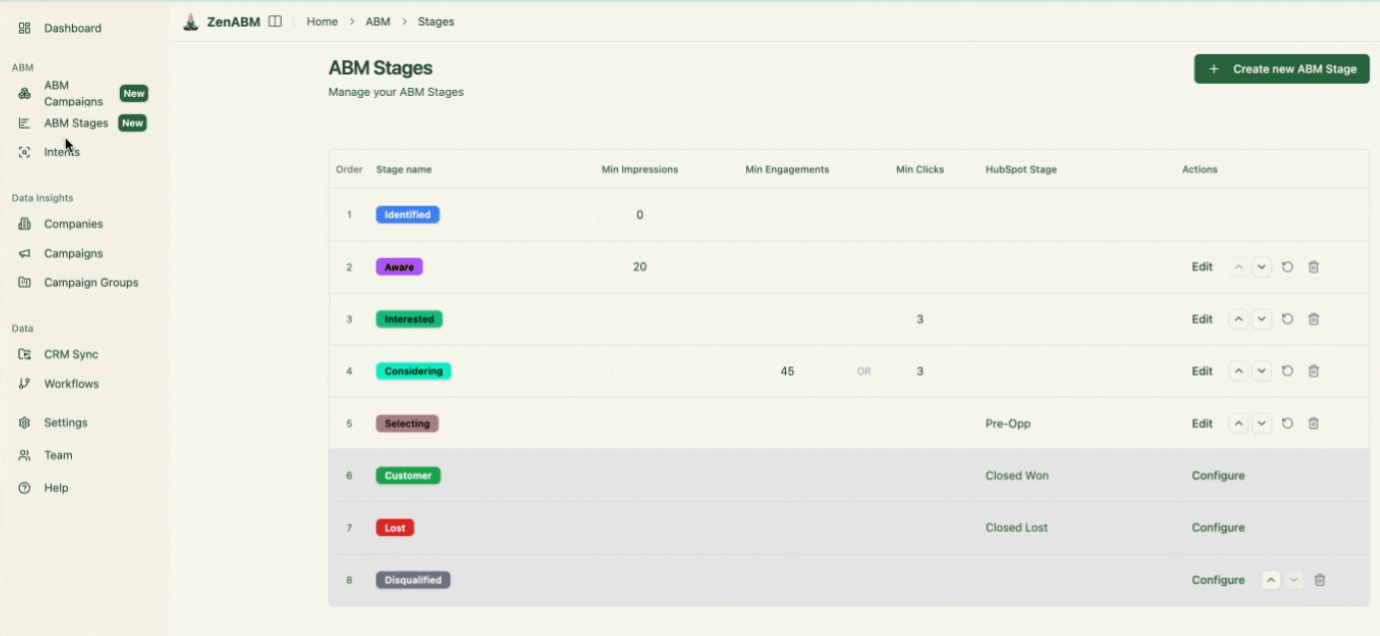

This delivers end-to-end visibility similar to large ABM suites so you can diagnose where accounts stall or advance.
CRM Integration and Workflows
ZenABM syncs two-way with CRMs like HubSpot and supports Salesforce on higher plans.
LinkedIn engagement is written as company properties so sales has full context:

ZenABM can mark an account as “Interested” once thresholds are crossed and auto-assign a BDR.

Intent Tagging from LinkedIn Ads Engagement
ZenABM lets you tag campaigns by theme, for example Feature A vs. Feature B, then shows which accounts engage with which topics so you see priorities.
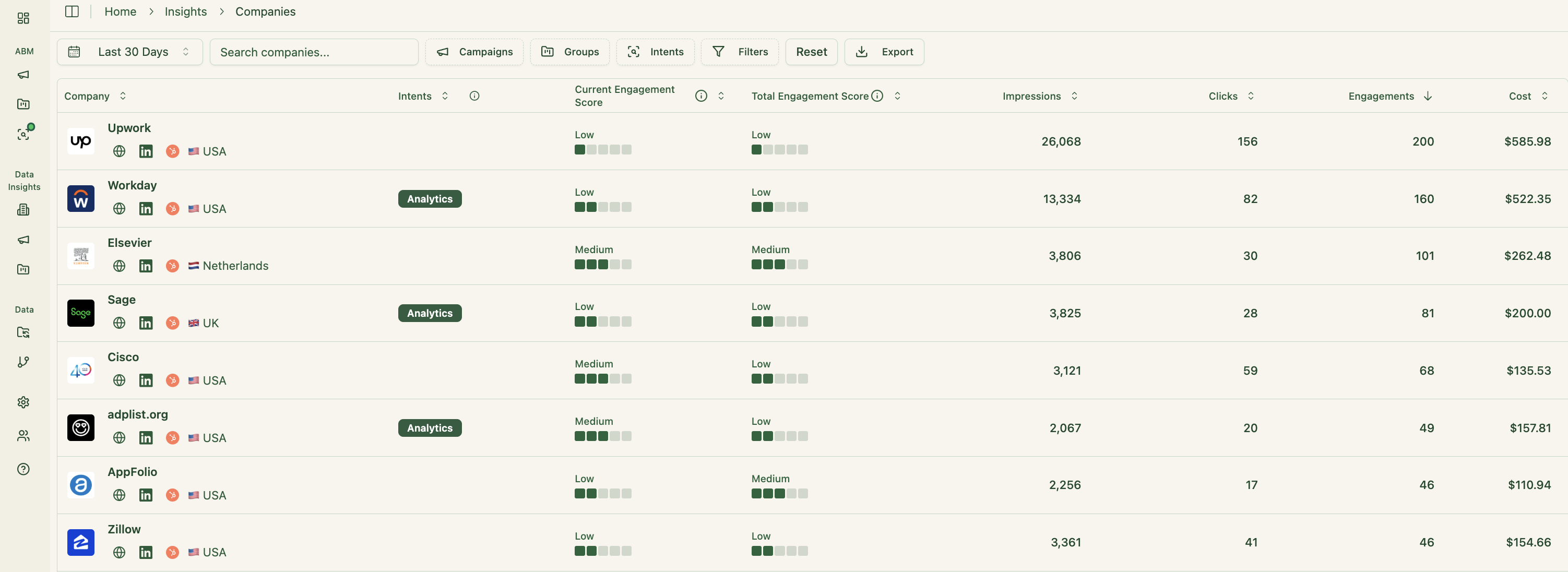
This is genuine first-party intent. Rather than pay for inferred keyword interest, you get proof that Account Z engaged with “Feature A,” a strong buy signal.
Those insights sync to your CRM for targeted messages and outreach.

Sales can immediately see which pain points and themes resonate for each account.
Built-in Dashboards and ABM Analytics
ZenABM ships with dashboards tying ad exposure, engagement, funnel stages, and pipeline.
- Track performance by ABM campaign, LinkedIn campaign group, and individual ads:
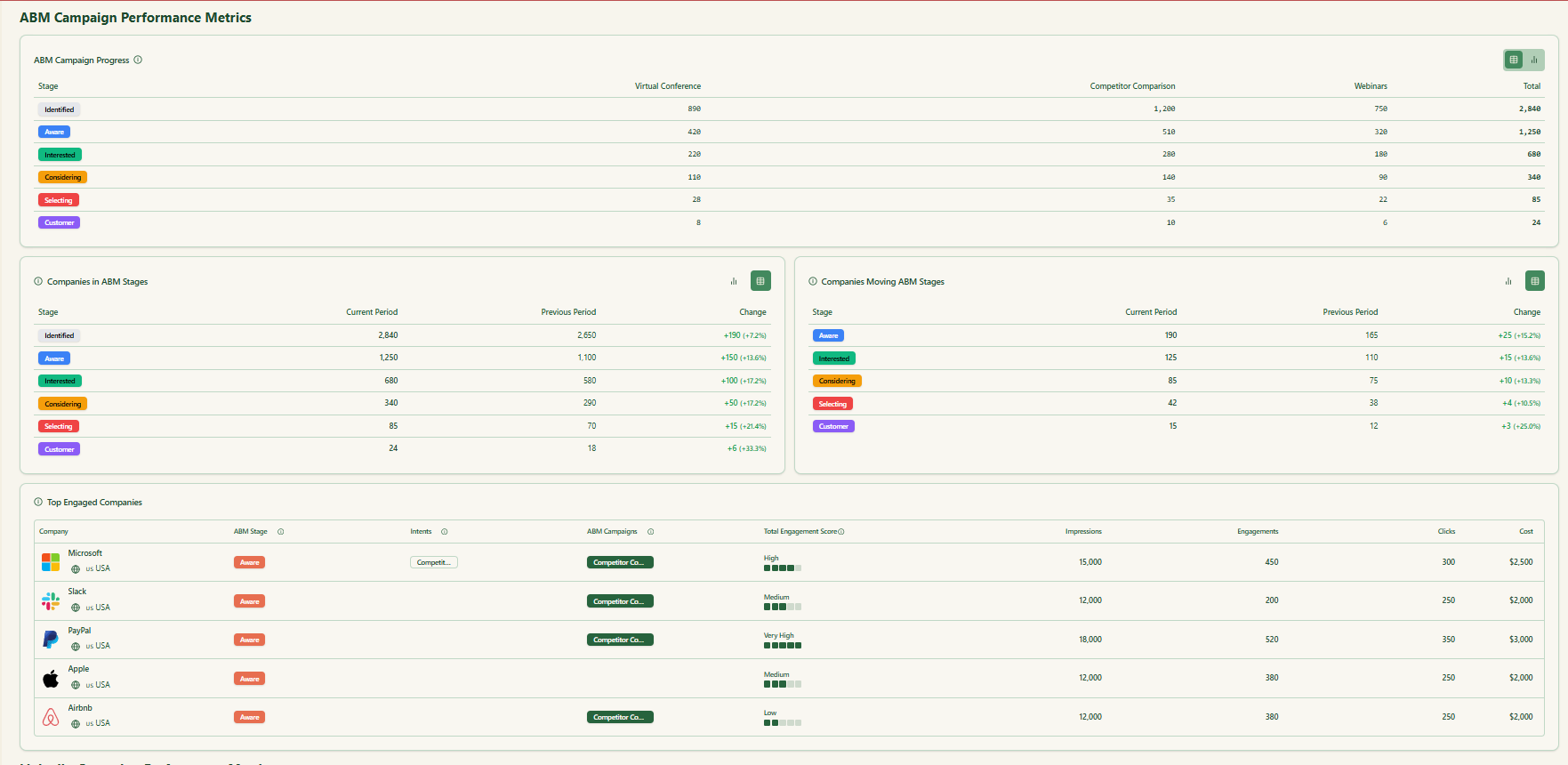

- Because ZenABM tracks both deal value and ad spend per account and campaign, it computes ROAS, pipeline per dollar, and revenue. This lets revenue teams optimize engagement and speed wins instead of chasing vanity metrics

ZenABM Pricing

Plans begin at $59 per month for Starter, $159 for Growth, $399 for Pro (AI), and $479 for the agency plan.
Even the highest tier stays under $6,000 annually, which is far below Factors.ai or Common Room.
All plans include core LinkedIn ABM features. Upper tiers raise limits or add Salesforce support.
Billing can be monthly or annual, with two months free, and there is a 37-day free trial so you can validate fit before buying.
Conclusion
Factors.ai and Common Room address different needs.
If your ABM motion is ad-led and you want firm control over targeting, retargeting, and budgets, Factors.ai is typically the faster fit.
If your advantage is capturing signals from product, community, social, and the website and resolving them to real people for timely outreach, Common Room usually returns more value.
Plenty of teams will combine a media platform with a signal layer over time, but there is no need to start heavy.
If LinkedIn is your primary channel and you want first-party, company-level engagement, clean ad spend to pipeline attribution, and simple CRM workflows at a fraction of enterprise cost, ZenABM can stand alone or augment either stack while you prove ABM impact quickly.



